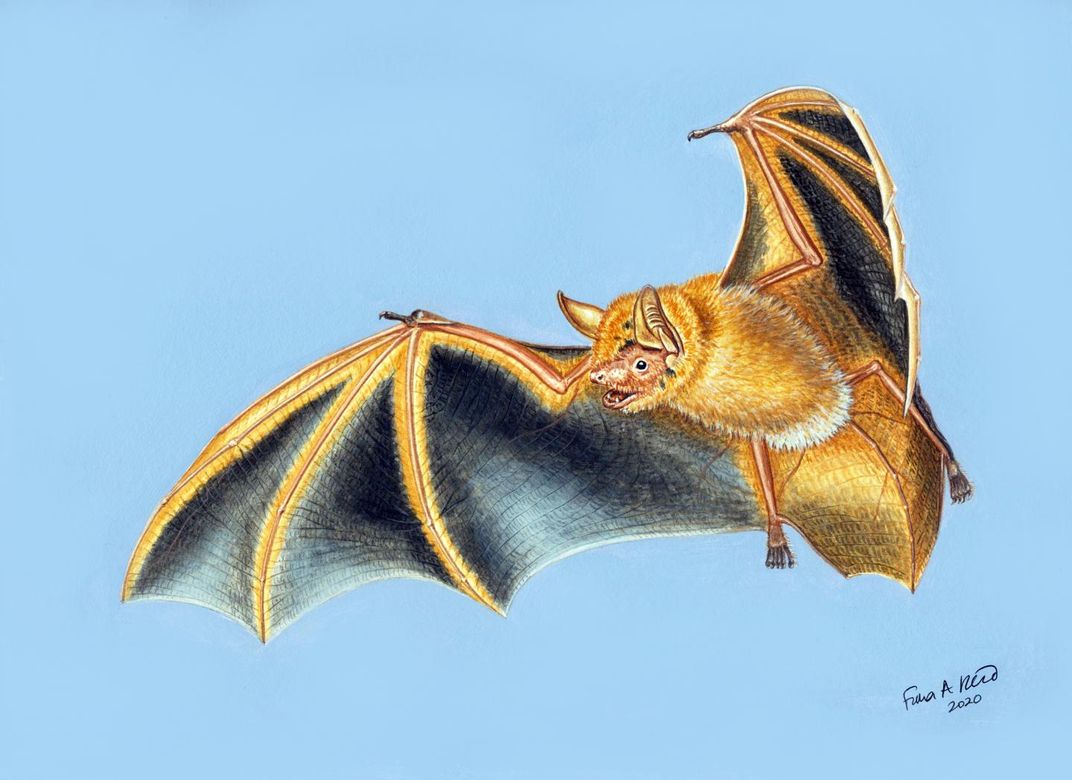Newly Discovered Bat Species Has Halloween Colors
The six-ounce bat lives in abandoned mine shafts in Guinea’s Nimba Mountains
/https://tf-cmsv2-smithsonianmag-media.s3.amazonaws.com/filer/3b/cd/3bcd10f6-4a49-47ed-9656-e4500d9fbe4e/jan15_orangebat.jpg)
With a large net and a stroke of luck, scientists have discovered a new species of bat that has bright orange fur and black wings. The researchers describe the species, which they name Myotis nimbaenis, in the journal American Museum Novitates.
Jon Flanders, the director of endangered species intervention at Bat Conservation International, was leading an expedition with eight other researchers in the Nimba Mountains in Guinea when they found the orange bat. Many bats live in the mountains’ abandoned mineshafts that are now unstable and unsafe to enter, so researchers tossed nets at the entrances to trap bats while they flew, reports Darryl Fears for the Washington Post. One night in January 2018, a brightly colored bat stood out among its dark-furred neighbors also caught in the net.
“The color is just phenomenal,” says Flanders to the Post. “Its wings are black with these orange fingers. There aren’t a lot orange bats in the world. I don’t tend to work with that many brightly colored bats. It’s definitely an unusual one for me.”

There are about 1,400 bat species in the world, including a few orange ones in China and South America—far from M. nimbaenis’ home in West Africa. For the past several years, more than 20 new bat species have been added to the list, but those discoveries usually come about when scientists tease apart the slight genetic and physical differences between nearly-identical species.
“This sort of situation where experienced researchers went out in the field and caught an animal and held it in their hand and went, ‘This is something we can’t identify,’ that’s much more unusual,” says the American Museum of Natural History’s curator of mammals, Nancy Simmons, to the New York Times’ Rachel Nuwer.
Flanders and his colleague Eric Moïse Bakwo Fils, a biologist at the University of Maroua, were looking for the endangered Lamotte’s roundleaf bat when they noticed a bright orange bat in their net, reports the Washington Post. At first, the scientists thought it might be an unusual color variation of an already-known species. But after the pair spent all night looking through identification guides, textbooks and online resources for a species match, they couldn’t find one.
“We walked in the room in the morning and simultaneously said ‘I think we’ve got a new species.’” Flanders tells the Washington Post.
To make sure that they had found something new, the expedition team re-captured the first bat they had found, a male, and another female specimen. Then they contacted Simmons, who is also the International Union for Conservation of Nature’s chairwoman of the bat taxonomy group. Simmons consulted the bat collections at the American Museum of Natural History in New York, the Smithsonian National Museum of Natural History in Washington, D.C., and the British Museum of Natural History in London to see whether any of their collections contained a match for the brightly-colored bat’s genetic blueprint or physical features.
The team concluded that the new species of bat is at least five percent different than the closest-related species, reports the Times.
Next, the scientists hope to study more about M. nimbaenis’ ecology—where it lives, what it eats, and what it needs in a habitat.
“These bats are found only in this area atop the Nimba Mountains,” Simmons tells the Washington Post. “They could have gone extinct and no one would have ever known.”
Because the bats are probably only found on these mountains, which are isolated peaks in an otherwise flat landscape, they are probably an endangered species. But Flanders tells the New York Times, “The more we know about it, the more we’ll know how to protect it as well.”